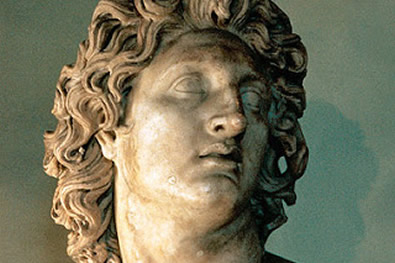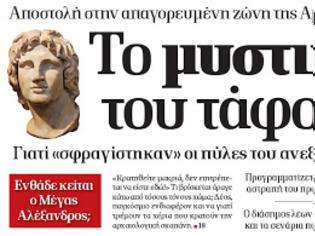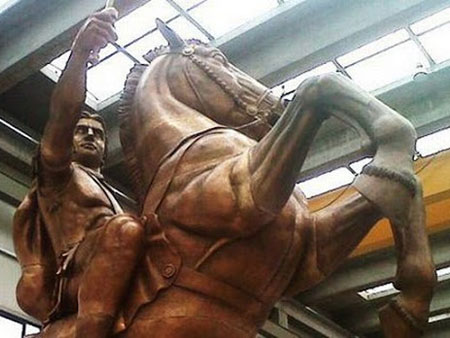The word ' paradise ' comes from the word paridaiza alfalfa, «fencing», with the pari to mean ' on ' and the daiza "wall / Wall». As often happened, the Greeks got their loans from the Iranian Medes rather than from the Persians: e.g.. the word satrap is alfalfa form this Iranian title (< xšathrapā(van), -Persian form xšaçapāvan). The ancient Persian equivalent of paradise is paridaida. The emergence of such a loan term as midikoy in Greek, but also in Akkadian, the Hebrew and Aramaic, It is further proof of the effect of the enigmatic Midwn. The same race has left very few traces, the early history is difficult to reconstitute, but the fact that the Greeks called them anatolites their opponents first Medes and Persians later only confirms their earlier importance. Similarly the Jews speak of Medes in Isaiah and Jeremiah, but for Medes and Persians in metaichmalwsiaka books of esdra, Nehemiah, Esther and Daniel.
Almost immediately after the Persian conquest of Babylon the 539 e.g.. find Babylonian documents decades of the sixth century, in which the principles of the temples is responsible for maintaining and establishing pardesu. One of them is vineyard, Another relates to planting Palm trees and brick construction. More information is available in only a few elamitika later texts. After the fall of the Elamitwn Empire in the seventh century, the Persians settled in its territory and kept the elamitika as their official language of bureaucracy in Louver until around 460. Here we find references to partetas, Word that corresponds to the ancient Persian paridaida. From the texts the following meanings emerge: partetas are storage areas for plant products, like figs, dates, peaches, apricots, pomegranates and kingly cereals, mostly pretty close to Persepolis. Although the size of a partetas was rather mediocre, It was big enough to contain the sheep to commemorate a religious ceremony, a sacrifice to Ahuramazda. End, There is a clear link with the trees. The dominant presence of trees due to the fact that the Persians attached particular value on trees. It already appears from a letter from Darius I in someone Gadatas, the caretaker of the local «paradise», the paradeisario, a term that is repeated in Syriac as pardayspana, in older texts the Armenians as partizpan, and in epic neopersiko as palezban. In the letter the King praises the Gadatas for the cultivation of fruit plants of Syria in Western Asia minor and reprimands for taxing Holy Apollo's gardeners. Someone Pythian, Perhaps the grandson of Growth, gave Darius a gold vine and platani, He remained well-known until Antigonus the melted the 316 e.g.. When he found a plane East of Sardis, Xerxes the decorated with gold and appointed a permanent guardian for him. Cyrus the younger showed in Lysander paradise at Sardis and claimed that he had personally planted some trees.
Therefore: at the beginning of the Persian Empire were two closely related words in current use for paradise: the term paridaiza midikos and the ancient Persian paridaida. The last word was adopted in Elamitiki, the first was adopted by the Babylonians, the Greeks and the Jews. Secondly the early Iranian paradise had no stable meaning. It could be a place for storing, a vineyard, Orchard, a stable, forest or tree nursery. Apparently, the most important and unifying element was the precinct. Thirdly, None of these descriptions do not fit even with the biblical Garden of Eden.
The connection between trees and heaven appears in the old testament, where in Nehemiah (2.8) the namesake protagonist asks wood from the Superintendent of pardes of King to make beams for the gates of the Palace. The passage appears to come from the original memoirs of Nehemiah, dating from the second half of the fifth century, and hence is a valuable testimony to the existence of the Persian havens, not only in Asia minor, but also in other parts of the Persian Empire. The Nehemiah does not indicate the location of paradise of, but may was in Lebanon. Trees are also mentioned in the song of songs (4,13 – 14), that might be written in Jerusalem around 400 e.g.. Here you will find a pardes of pomegranates, with pleasant fruit, nardo, yolk, cane and cinnamon, with all its frankincense trees. There is a possibility that the word "paradise" appeared in Greek literature in the fifth century. Clearchos (Re. 43a) says that the Lydians in their luxury built havens, forming them like parks, and so they lived in the shade. As clearchos elsewhere used the history of Xanthos by Lydia, a premier contemporary of Herodotus, It seems likely that the Xanthos was perhaps the first Greek writing used the term paradise. This is not unlikely, Since he came from Lydia and he may well be their havens of Sardis knew personally. As fit in paradises, It consisted of trees, but the Sardioi apparently had them turn it into a more cultured environment than the standard Persian havens, Maybe with pavilions for their visitors. In any case, There was a home and a place with four-poster bed in babylwnio paradise, where he died Alexander. At first glance it may be surprising that speaks to clearchos paradises in the plural, but the texts often speak in this way. Some examples are havens in Susa (Αιλιανός, On animals 7.1), the wild parks of Pharnabazus (Xen., ELL. 4.1.15, 33), the hunting provided havens in Demetrius Demetrius Poliorcetes in the place of exile of (Plutarch, Dimitrios 50) and the Syrian havens with Cypress referred by Theophrastus (Plants (p). 5.8.1).
From the testimony of Xenophon (Economical, Greek, Anabasis, Cyropaedia) and other Greek writers, but from the biblical passages, We can draw the following conclusions about the meaning of havens in late Achaemenid Empire: Firstly, the passages of Nehemiah and the song of songs seem to indicate that, Besides the paradises hunting approved by Xenophon, other meanings of the Persian paradise, such as Orchard and tree growth place, remained live. Secondly, the early Greek havens connected with people only to a limited extent. There are orchards, vineyards or storage locations-concepts for which the Greeks certainly had their own words. From the other side, as explicitly stated in Greek. 4.1.15, It was fenced and in this regard reflect the Iranian origin. Thirdly, seems to be a relatively unknown phenomenon for Greeks, After being on the Economic of Xenophon effectively covers the term saying that there are parks, the so-called havens, where goes the King. Fourthly, These specific havens were characterized by limited size, the proximity to other havens, την presence of animals, water (whether River or a Lake), the importance of trees and, in General, from lush vegetation. These havens are not absent from the Persian heartland, After Susa ardeyotan paradise (Ctesias FGrH 688 F 34), and the tomb of Cyrus in Pasargadae was located in a paradise with a grove of all kinds of trees, ardeyomenos, and deep grass had grown on the Prairie. Fifth, the havens were in possession of the highest Persian nobility. Hence became the symbol of the Persian authority, as it seems to indicate the selection of Palm trees to pose as their first target in their rebellion 351 e.g.. the Royal Paradise. Sixth and last, Unlike the paradise of Genesis, the havens were primed with hunting wild animals and thereby allow the Persians to keep themselves well prepared for war.
After the fall of the Achaemenid Empire havens quickly disappeared hunting, After the hunt does not play the same role in the lives of his successors Megalou Alexandrou, as between the Persian rulers. However, other havens continued to exist, but without the wild animals. We can make this change already quite early in the third century, After the 246 e.g.. the small Cretan town of Itanos devoted a "holy shrine" near the gate, probably a public garden type, as a paradise for Ptolemy Iii (246-221). This certainly wasn't a hunting park. Neither, apparently, the havens were associated with Royal residences, referred to scrolls at the end of the third century. Other combinations of palaces and parks clearly show that these havens were parks. In the third and second century, the paradise is connected with water (Numbers 24.6, Isaiah 1.30), trees (Ezekiel 31.8,9), contrasts with the desert (Isaiah 51,3) and it is a sign of great wealth (Ezekiel 28.13), but nowhere do we hear about animals. In Ecclesiastes, that seems to be dated to the third century b.c., Solomon says: "I've made myself gardens and pardesim, and I planted trees in them of all sorts of fruits» (2.5). As in the above-mentioned case in song of songs, modern translations use the term "Orchard", and indeed, in modern Hebrew the word "Orchard" is pardes. Most orchards are listed in downstream Papyri from Egypt, containing many references to havens. These havens were utilitarian gardens, Since the average size is extremely small, smaller than a hectare. Hence, It is not surprising that we hear about them be sold or purchased. In Roman times the havens became even more cultured, as follows directly from the paradises in the Greek novels scrub and Achilles Tatioy. There are still springs and trees, but the landscape has become far more artificial. We are now seeing the presence of meadows and flowers: Roses, daffodils and hyacinths. Instead of a wildlife paradise inhabited by swans, parrots and peacocks.
Before answering the question why the Septuagint, in the third century b.c., they chose the term ' paradise ' to translate the Hebrew term Gan Eden, We have to solve another problem. Because the translators do not prefer the equally likely Greek term "Garden"; As the paradise, the garden is connected to the water (Isaiah 1.29), but it is clearly simpler than the magical paradise (Deuteronomy 11.10, 1 Kings 20.2). These gardens are cultivated primarily for their productivity and was closely connected with the housing estates. It was small, fenced, cultivated intensively and were famous for vegetables and flowers. In other words, for Jews the word translators garden hardly conjured up the image of a Royal Park worthy of Yahweh.
But if the translators preferred the word paradise, whom Heaven have in mind; We can reject the old Persian notions of "warehouse" or "vineyard" and use for hunting in Xenophon, Since neither God nor Adam show no interest in hunting, Neither drink alcohol. It is almost certain that we can ignore their havens also eventually Hellenistic and Roman Egypt, Since it was too small, too simple and too utilitarian to be worthy of Yahweh. This leaves us the modern Royal paradises of the Hellenistic period, as it is visible in various descriptions: Royal Parks with many trees, suitable for walking, less boisterous than their forerunners the Persian, but more wooded than the late Roman offspring. Such parks natural fit with the time of the Septuagint, i.e. Alexandria during the second quarter of the third century BC.. Our knowledge of early Alexandria is incomplete, but it is increasingly recognized that the Royal Palace of the Ptolemy Ii drew inspiration from Persian palaces with havens. The Paradise seems actually imprinted on the description of the Palace of the King of Colchis from Aiti on Apollonius the Rhodium (Argonautica 3.219 – 29). There is also a clear indication of the connection of paradise of Yahweh with the world of Ptolemaic Dynasty: the translation of expression Gan Eden in Genesis (3.23) as a "paradise of tryfis». The "tryfi" was a term widely used in Ptolemaic Dynasty monarchy to characterize the peaceful life with prosperity and magnificence. Three kings were branded "Tryphon" and several princesses ' Tryfaina». In Roman times the tryfi became synonymous with the "good life". Clearly the era of Ptolemy was no longer the era of Cyrus with physical discomfort and sweat, but the world of wealth, comfort and luxury. Back from paradise of heavenly King in the Septuagint were concealed the cultured havens of earthly Egyptian Greek sovereigns of modern.
* Απλοποιημένη εκδοχή από το Bremmer, “The Birth of Paradise”, Greek Religion and Culture, the Bible, and the Ancient Near East, Brill 2008
http://heterophoton.blogspot.gr











































